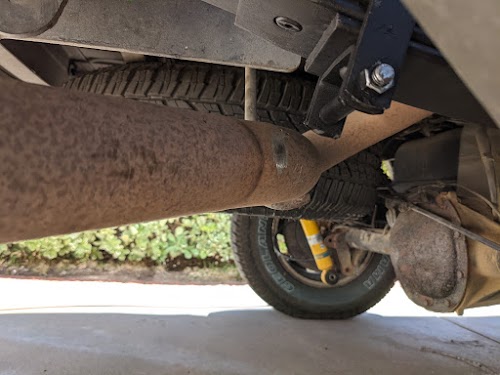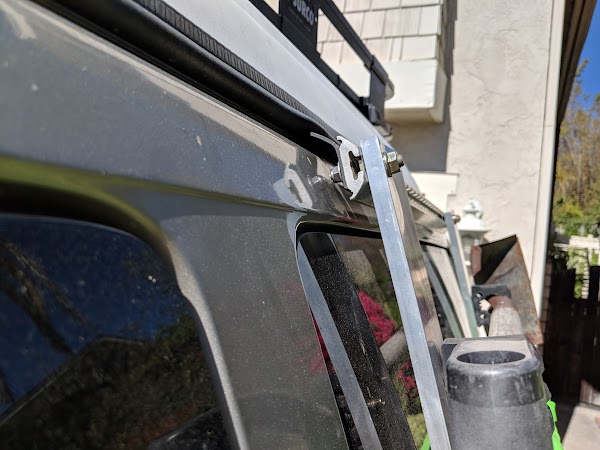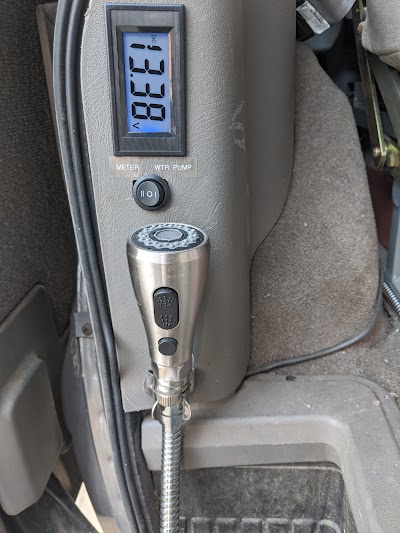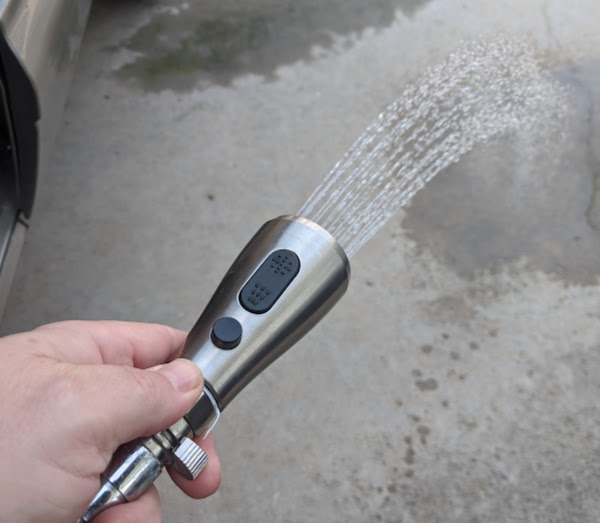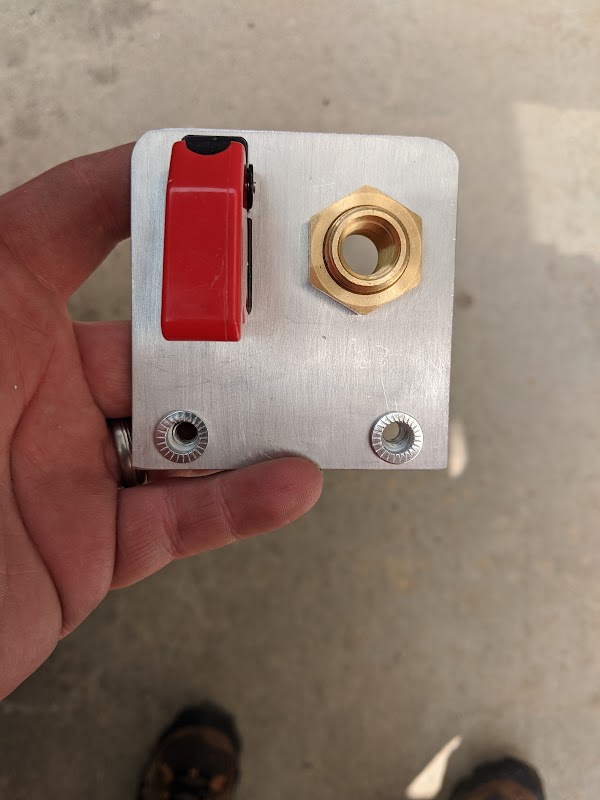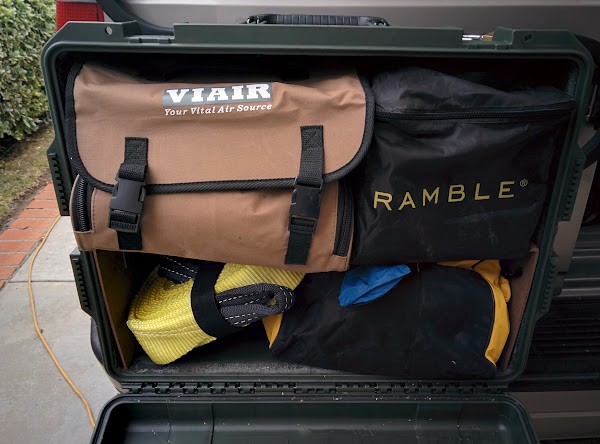So aside from a few COVID-projects to optimize a couple parts of the van, things have been pretty stable/reliable for a while. After a particularly hard push at the day job, I took advantage of a free day to take a solo overnighter up to one of my favorite areas in the San Bernardino National Forest. Access is via a pretty good FS road, but there are a few spots where the graded dirt gives way to a vein of rock poking through the terrain.

Coming down after a great night of photography and relaxation, I was feeling pretty good - and maybe not crawling quite as slowly as I should have been. Dropping the rear end off of the "step" formed by one of these rock veins, I heard a pretty significant clunk from behind me. Upon inspection, I found that I'd sheared the shaft of one of the rear shocks:

Once freed from the upper mount, the shock flopped over to rub against the muffler - hence the melted boot. I also severely bent the upper mounting bolt (single shear), such that it had to be cut out in order to replace it.
After a little time spent taking measurements and thinking about the failure mode, it became pretty clear that what likely happened was that I over-compressed the rear suspension without appropriate bump-protection, and something had to give. I'm honestly surprised it hadn't happened sooner - the rear of my van is VERY heavy (right at or just over the 3100lbs GAWR), and the S-10 springs (1350lbs rated) were over-loaded. This had led to them sagging over time. Combined with the relocated shock tabs and OEM bump-stop height, this created a condition where the reduced neutral suspension height was such that with a big compressive moment (such as coming down off a bump with all the weight of the ass-end) could get the ride height shorter than the minimum length of the shock. I had been noting that the suspension was riding low, so it was entirely stupid that I didn't address this sooner.
Needless to say, more than a replacement shock was in-order.
As I'd already noted the sagging springs, uprated 22-687HD springs (rated to 1750lbs) had already been ordered and were sitting in my garage. These were fitted, and I also fabbed a set of 3" risers for the bump-stops:

Combined with the more appropriate spring rates, I was now back at my intended lifted-height, but found that GM's OEM clamshell arrangement for fixing the springs to the axle didn't easily accommodate the thicker 4+1 spring pack:

The upper clamshell half is supposed to meet the lower. While I had sufficient bolt-thread through the nut, the tension there was flexing the 1/8" steel of the upper clamshell in a way that didn't inspire confidence. Some folks have stacked washers or a spacer into that gap, but I also disliked that the studs coming up from the tube bracket were so short that it was very difficult to get things "started", so I went looking for a better solution.
The tricky thing is that in the original design, the top of the spring pack operates pretty close to the "rail" in the rear body. Upward-facing U-bolts will definitely interfere with suspension movement. Instead, I adapted a solution I've seen on other Astros with a thicker spring pack:

I did not want to modify my original hardware since I wanted to be able to reverse this if it didn't work out, so I started at the junkyard and picked up another pair of upper clamshells and TWO pairs of the lower axle brackets with the studs.
A little time with a cutoff wheel was needed to remove the studs from the tube brackets and to clearance the upper clamshells for the U-bolts:



Due to how my weekend schedules worked out, I had done all this prep work on these brackets a few weeks in advance. When it came time to actually install everything on the van, it was pretty much a bolt-on operation. Is this what it's like for the Jeep guys who just buy everything off the shelf? Child's play!

A few quick notes for any other Astro/Safari owners who may follow behind me:
- At my local yard, there was one fairly late-model van (~2000) and one older van with the fiberglass leaf setup - I took the upper clamshell and lower tube brackets from the newer van (a match for mine), and the 2nd set of lower tube brackets from the older van.
- I noticed that the fiber-leaf tube brackets are "shallower", so I put these on the inboard-side of the arrangement (left in the above photo) so that they wouldn't touch the lower-clamshell bracket that's fixed to the axle. With the stock leaf-pack, the lower bracket, lower clamshell, and upper clamshell all meet and you tighten the sandwich together. In this case, that won't work, and I didn't want the lower bracket pulling UP into the welded-part of the lower clamshell (and I didn't want to have to cut it off), so the "shallower" tube bracket worked out great.
- The U-bolts are part #BT5-0111S from AutoAndTruckSprings.com - they're 9/16" diameter, 3-1/2" inside width, and 8-1/4" long
- I could probably have got away with a slightly shorter bolt, but there's a lot of compression with the OEM rubber pads, so this made it easy to get the nuts started.
- I probably didn't need 9/16" bolts, but from this supplier, those were the only parts with 3-1/2" inside spacing. If you find 1/2" or even smaller U-bolts from another supplier with the 3-1/2" spacing, that would let you install these without drilling out the brackets. The 3-1/2" spacing makes it possible to re-use the existing inboard bracket holes without having to slot or grind anything (other than enlarging the diameter of the holes with a drill).
I had one other side-effect from the new HD spring pack: with the same nominal +4 arch as the S-10 springs, but a more appropriate spring rate, I've got slightly deeper arch in the pack, and I got interference between the "rebound clip" and the exhaust pipe after the muffler. A torch and a couple of burly dudes at my local Midas sorted this out for a coffee-money sized tip:

